

Sakai, C.E., Connolly, S.M., & Oas, P. (2010). Treatment of PTSD in Rwandan child genocide survivors using Thought Field Therapy. International Journal of Emergency Mental Health, 12(1), 41-50.
Pasahow, R.J. (2009). Energy psychology and Thought Field Therapy in the treatment of tinnitus. International Tinnitus Journal, 15(2), 130-133.
(This article contains two case studies in which Thought Field Therapy was found to be effective in treating anxiety and depression symptoms in participants who were suffering from tinnitus.)
Schoninger, B., & Hartung, J. (2010). Changes on self-report measures of public speaking anxiety following treatment with Thought Field Therapy. Energy Psychology: Theory, Research, and Treatment, 2(1).

By Paul Oas, M.Div., PhD., TFT Dx
 |
The “Street Children” of the El Shaddai Orphanage in Kigali, Rwanda |
In April of 2006, a 10 member Mission Team traveled under the sponsorship of the ATFT (Association for Thought Field Therapy) Foundation, www.TFT.org., to Rwanda and the Congo to do research and provide trauma therapy and training. They used and taught the revolutionary process of trauma relief developed by Dr. Roger Callahan, author of “Stopping the Nightmares of Trauma.” (For a brief synopsis of the TFT process, see www.TFTrx.com.)
Below see the heart-opening experience of the ATFT team being welcomed by 400 singing orphans. You can also see other ATFT videos on YouTube.
The ATFT Trauma Relief Team being welcomed by 400 singing orphans.
Their focus was primarily on the 400 “Street Children” of the El Shaddai Orphanage in Kigali, Rwanda, “home” for those orphaned by the 1994 genocide and subsequent AIDS and poverty.
 |
| El Shaddai Orphanage, “home” for those orphaned by the 1994 genocide and subsequent AIDS and poverty. |
The Team was co-sponsored by Christ Lutheran Church in San Diego, who has raised $35,000 of the $48,000 pledged to feed and bed the 400 orphans for a year. Five of the Team were from CLC. (www.Christpb.org).
This team’s mission statement was: “To help create healing and stability in Rwanda by using Thought Field Therapy to heal the wounds of trauma and by training Rwandans and the Congolese to use TFT to help their fellow citizens heal the wounds of the past and move forward to create a strong, peaceful and healthy nation.”
The goals of the 2006 mission team included the following:
 |
| Our travel-weary volunteers, captivated by the singing orphans. |
What motivates 10 Americans from the ages of 29-75 to leave jobs, practices, spouses, children and the comforts of home to travel thousands of miles to the heart of Africa – a country replete with war, genocide, corruption, disease, poverty and seeming hopelessness?
You will have to ask them!
I can only share some observations.
In selecting the team, these were the qualities I initially looked for and found:
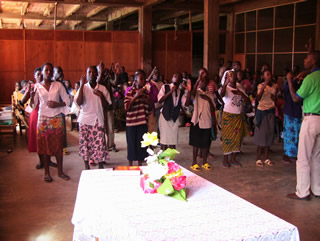 |
| Flowers, smiles, song and dance greeted our tired team upon their arrival. |
On the road, April 10:
 |
| Smiling faces and inquiring eyes, filled with hope for what we may be able to do.
|
Toss in 2 sleepless nights on crowded airlines by team members attempting to bivouac in Nairobi from Hawaii, LA, Phoenix, DC and Kuait, a flight cancellation from Nairobi, Kenya to Kigali, Rwanda, and arriving “shower less” and disheveled 4 hours behind schedule.
Reluctantly we honored the insistence of Pastor Peter Ilungalutum, the Director of the El Shaddai Orphanage, to “stop by” and be welcomed by 400 children orphaned by the 1994 genocide, AIDS and poverty.
We were bounced and whisked to an abandoned warehouse where these hundreds of former “street children” had been waiting 4 hours to welcome our arrival.
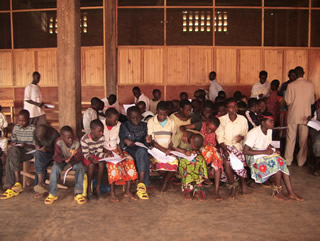 |
| Genocide victims, both young and old, working hard to fill out their PTSD questionnaires. |
What we experienced then was impossible to describe without tears welling up again. It was for me the signature experience of our mission. As 10 weary travelers descended from packed Land Rovers into a cave like entrance to the warehouse, voices of 400 orphans singing at the top of their lungs was overwhelming in its stark contrast to what we anticipated.
We saw faces beaming with joy and animation, eyes wide with excitement. For over an hour they mesmerized us with singing and dancing. Like Ravel’s “Bolero,” the beat and dance escalated until our “Raggedy Ann” travelers were “seduced” onto their feet – joining hearts and feet in a crescendo of connection.
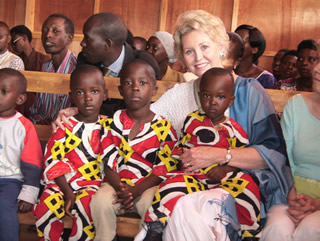 |
| Dottie Webster sharing Easter Sunday with the orphans. |
We were there to “heal” them? This experience alone was worth the “price of admission.”
With but an hour to travel to our lodging, splash water on our faces, run a brush through hair – most were on time for our 4:00 p.m. staff meeting with our local hosts and Embassy volunteers.
The Presbyterian Guest House was our domicile for the next two weeks. There were clean rooms, mosquito net draped beds, showers and bath. (Electricity and hot showers were sporadic, but “shower sharing” rescued us.)
 |
| Caroline Sakai explaining about the TFT therapy and study. |
Tasks at hand:
Due to typical African communications, Suzanne Connolly’s training of 35 psychologists, pastors and teachers was postponed for 10 days.
This allowed time for Caroline Sakai to rally the team to the task of therapy and research. Having recently returned from two deployments to New Orleans and Green Cross Certification, Caroline launched into the formidable details involved in adequately translating our PTSD approved testing instruments into Kinyarwandan and receiving approval by its author. This became an amazing team effort requiring many trips to the Internet Café until appropriate and adequate translations were acceptable and in place.
The team worked till late at night assembling research and training materials. Days were spent in testing and treating as many children and staff as possible.
 |
| Additions to daily protein and nutrition were welcomed. |
Meanwhile, 3 of the team, Carl Johnson, Beth Bates and Paul Oas left for the Congo and Northern Rwanda to provide training and follow up continuing education for last year’s trainees in Goma and Ruhengeri.
Now, time for a weekend break!
Six of our team journeyed to the mountains separating Rwanda from Uganda and the Congo to track down the elusive Silverback Gorillas of “Gorilla’s in the Mist” fame.
Their mountain climbing trek through thick jungle rewarded them by a literal “brush” with the gorillas and left them rain soaked and mud caked as ecstatic reincarnations of “Diane Fossey.”
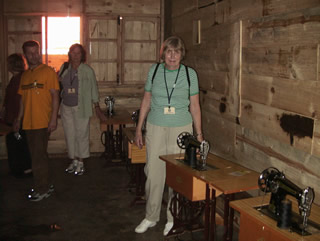 |
| We taught the children to “sew” with the donated machines. |
Our final week was no less exciting and rewarding. 35 students arrived from the Congo and various parts of Rwanda for the two-day training in TFT. (Due to the extreme poverty in Africa, it was necessary to subsidize students for travel, food, lodging and training.)
The training was led by Suzanne Connolly, a seasoned tutor and traveler. Since January, she already had two training deployments prior to Rwanda: New Orleans and Kuwait.
With 6 assistants and a translator, the students not only learned the basics, they also experienced relief from their own pent up traumas, which helped solidify their education and experience.
 |
| Suzanne Connolly leading the TFT Algorithm Level training for the local community. |
The remainder of our time was spent in treating as many of the orphans and staff as possible and to ensure that protocols for research follow up were in place.
Farewells were heart wrenching, as affection-starved children were once again being “abandoned.” Clothes were drenched with intermingled tears as orphans clung to new friends and “surrogates” from America.
It was now impossible to determine — who had healed whom?
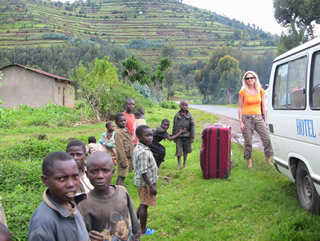 |
| The sad good-byes. |

“We Appreciate Your Services.”
Purpose: to make as meaningful as possible this life that has been bestowed upon us, to
live in such a way that we may be proud of ourselves, to act in such a way that some part
of us lives on.
Oswald Spengler, German Philosopher
Kigali is a city set among gently rolling hills that bask in the equatorial sun by day and
sparkle with a generous scattering of electric lights by night. Women in traditional
brightly colored dress carry baskets of bananas and other fruits and vegetables gracefully
balanced on their heads. Men balance heavy sacks of beans, potatoes, refuse and wood
upon their heads and shoulders as they nimbly make their way through traffic and up and
down hills. Horns honk as skilled drivers somehow avoid hitting pedestrians, taxis,
buses, motorcycle taxis and each other.
Outwardly peace reigns in a land just thirteen years ago devastated by a genocide in
which over eight hundred thousand men, women and children lost their lives within a
four month time span. Inwardly there continues to be much suffering. Those who can
remember the genocide horrors of 1996 and the genocides of years- prior cannot easily
forget. There is no one in Rwanda whose life has not been touched and forever changed
by these events. It’s difficult to imagine.
It is difficult to imagine because we have been sheltered from such tragedies and
although we hear the stories it seems surreal. We try our best to imagine what it would be
like and try to put ourselves in their place. It is difficult to imagine because there is an
aura of peace and people of all ethnic groups are mingling once again despite the
memories that haunt them from within.
We have come as much to drink in the sights and sounds and beauty that is Rwanda as to
help alleviate the unspoken inner sorrows of those whose lives we may be graced to
touch. As for some of us, Paul Oas, Dottie Webster, Caroline Sakai and myself and our
all-around man Tim Botsko from Paul’s Church, this is not our first trip to this part of
Africa and we already know what the other nine members of the team will soon find out.
What we five already know is that Rwanda will give us back more than we will ever be
able to give.
It is time to leave Rwanda and I leave the guesthouse that has been my home for over two
weeks in the early morning darkness. Caroline and Dottie have left earlier in the week
and the rest of the group will leave later this morning. I am driven to the airport in a taxi
and accompanied by a man known as Safari whose name is Jean Damascene. He has been
an invaluable friend and coordinator for us all and we hug good-bye.
As I go through the security gate, the guard asks the purpose of my trip. I have been
trained to say “tourist” but I have filled out a departure card and list my occupation as
Social Worker. I can’t resist the temptation to say “ And I’ve done a little volunteer
social work while I’m here also.” He looks me in the eye and quietly says, “We
appreciate your services.” It’s nice to hear and I feel good inside. Mother Theresa once
said, “I know that what I do is only a small drop in the ocean but it is a drop.” We hope
we have added a few drops to the good work that is occurring throughout Rwanda.
We have accomplished a lot for the short time we’ve been here. Jim Hall, a Dentist
accompanying our team from San Diego, has examined the teeth of 400 orphans and
taken those most in need to a local dentist who will continue to follow up with the
children of El Shadai. Paul’s Church, Christ Lutheran in San Diego, CA has agreed to
pick up the continuing expenses. Jim has taught the children the importance of brushing
their teeth. He has let them know how important their teeth are and how important they
are. Jim wonders what place the children who sleep four and six to a bed will find to
keep their toothbrushes.
But the children will have a place to brush their teeth and to wash their hands. Our
wonderful health team has paid a carpenter to build a washstand and they have placed a
jerry- can with a spicket on it. Now hands can be washed after using the latrine and
before eating.
The really good news, as if all that wasn’t enough, is that the children now have, for the
first time, safe water. Paul Oas and Jim Hall were able to arrange for an up- to- date
water purification system to be installed where none has been before. This will
undoubtedly cut down on the diseases that plague the children. Miraculously, this water
system was donated and installed free of charge.
Whitney Woodruff, a Nurse Practitioner and her two fellow nurses, Joanna Ransier and
Kelli Barber have done the impossible. They stayed up to the wee hours of the night
creating medical charts for all of the children and took those most in need to see a local
doctor. The kindly local 7th Day Adventist Doctor will be following up with the
children’s medical needs and even visiting the children at the orphanage on a weekly
basis.
The Nurses identified cases of Typhoid and Malaria and, most dramatically, saved the
sight in one young boy’s eye. The boy, J., had been poked in the eye with a stick a month
before our arrival. He had received no medical attention and one eye was oozing pus and
the other in immediate danger. Antibiotics were able to stop the infection and prevent
blindness in the one eye although it was too late to save the other.

Boys quilting
The self-help quilting project first conceived by Dottie Webster and myself was off to an
impressive start. A quilting instructor, Daisy Gale from Utah, accompanied our team and
I brought six sample quilts created by the Red Rock Quilters of Sedona. The Sedona
women are fabulous quilters and the stunning quilts they provided were created entirely
of African fabric brought back to the States last year by Dottie and myself. The sample
quilts were a hit with everyone and the children, with Daisy’s help, created their first
quilted wall hanging. Dottie and I have been able to sell the first quilted wall hanging for
$400.00 proceeds which have been sent back to the orphanage.
The proceeds from the sale of the quilt will go back to the school quilters, older boys who
need a way to make a living once they leave the orphanage, and one half of the proceeds
will go to the orphanage itself. Dottie and David Webster have hired and are paying the
salary of a business manager for the quilting project and a local sewing teacher has been
hired to teach quilting. My husband and I have agreed to pay the salary of the quilting
teacher.
Dottie Webster worked day and night before our arrival in Kigali, doing the necessary
paperwork to submit a grant application for this self-help project to the American
Embassy. Paul, Dottie and I met with the United States of America Ambassador to
Rwanda, Michael R. Arietti, for about an hour and had a nice chat and plugged the selfhelp
quilting project. We look forward to the project growing to eventually include more
children.
Caroline Sakai led our team in the one-year follow up to the TFT research that was begun
one year ago. We also offered to treat the children for any problems, which hadn’t been
resolved during their prior treatments a year ago, or for any new problems that had arisen
since we had last been there. Alas, most children had only health problems that needed to
be addressed by our medical team. When it came to emotion problems they collectively
reported no more “bad dreams during the day”(AKA flash Backs), no more nightmares,
fewer bed wetting incidents, less anger, fewer headaches, increased ability to concentrate,
improved ability and confidence to mingle with others, less shyness and more self
esteem. Many said they had no problems at the moment but when problems did come up
they did the tapping. Thanks to Roger for this gift and thanks to The ATFT Foundation
for making this trip possible.
We were also able to treat several new children who hadn’t received the benefits of TFT
during last year’s visit to El Shaddai.

American TFT’ers with teachers also trained in TFT
Left to right middle row: Suzanne, John, Dottie, Sandrine, Rose, and Caroline. Back row:
Interpreters, Billie and Marcelle. Front row: Head teacher Julienne and Sylvestre
Caroline and Dottie, two outstanding trainers and therapists, and three interpreters
assisted me, as we trained 52 people in our first two-day algorithm training during this
mission. Meeting Rooms, supplies, transportation and lodging were all paid for with
contributions from the ATFT Foundation.

Class of April 2007, Kigali Rwanda St. Paul’s Training
Several of our new trainees held government positions relative to the treatment of trauma.
ABATONI Jane GATETE, the executive Secretary of Association Rwandaise des
Consiillers en Traumatisme with the Ministry of Health, had us over to their new
counseling facility following the training. She expressed interest in us training even more
therapists in Rwanda next year, perhaps at their impressive and expansive new facility.
The day after the algorithm training we facilitated a review training, attended by 20 of
last years 33 trainees. Attendees came for the review training from throughout Rwanda
and the Democratic Republic of the Congo. They were an enthusiastic group and shared
success stories of using TFT with others and themselves. This group also attended
compliments of the ATFT Foundation.
The next week was lonely without Dottie and Caroline. I did an impromptu one-day
introduction to TFT training for a group of Christian Women Counselors, Women’s
foundation Ministries that constitute the most utilized therapy group in Rwanda. They
were an impressive group of women with a strong women’s rights agenda. Their goals
according their brochure included, “…to be good leaders for the Nation and not be
leaders in the “Kitchen.” Their motto is Faith in Action and the leader of the group and
some other women present had recently returned from Darfur where a group of Protestant
women and a group of Catholic Women had gone to treat Muslim women for war related
trauma.
The women were impressed with the dramatic results achieved in such a short time and
want to find a way to have more training. Their own life stories were often heart
wrenching but it was a privilege to have been a part of their healing through Thought
Field Therapy.
The next day was a two-day training sponsored jointly by US Aide, Catholic Relief
Services (CRS) and ATFT. US Aide is working with established groups such as CRS,
CARE, and World Relief that have proven over time to be effective and efficient in
delivering social services in Third World Countries. This training was attended by 29
social workers, Nuns, Brothers and lay persons who work with street children. The head
of CRS in Rwanda, Sean T. Gallagher, gave an opening speech and Pascasie
MUSABYEMUNGU, safety net coordinator gave a warm welcome.
Gabriel Constans assisted me in this training and was especially valuable with his help
during the small group practices. This group provided a meeting room, audiovisual
equipment, meals, transportation and even lodging for those who came from far away.
ATFT paid for the manuals and the interpreters. The twenty- nine attendees all work
with the 24 CRS safety net centers for street children located throughout Rwanda. I
adopted this training and the others to include new information on what children who
have been traumatized need in order to recover from trauma.
The day after the CRS training I was picked up by Pascasie and we visited two
orphanages that also take in street children. The first orphanage I visited was an
orphanage financed and run by a family in London and dedicated to the care of Muslim
orphans. It was well run and staffed by a combination of Muslim and CRS workers.
There was a young man that was of special concern due to his unique traumatic
experiences and I had been brought there to treat him. I exchanged a few friendly words
in Arabic, the only ones I know, and the effort seemed to ease the tension in the room. I
treated the young man, a street boy, for three traumas and he seemed much better. The
young man had endured great suffering and I was so pleased that TFT was able to help
him.
The next orphanage we visited was a well-run Catholic orphanage that took in children of
all faiths. They had cows for milk and chickens and turkeys and a garden and a fishpond
that farmed tilapia. But they had a limit to the number of children they could care for full
time. I was asked to treat two street children that were given school uniforms to wear and
hot meals whenever they could make it to the Center. However these children have no
means to attend school. Locally, my hair stylist and friend, Jeff Nigelski, who doesn’t
accept tips, had his clients donate money to a fund for these two older children. The
money already collected will send both children to school for one year.
Gabriel Constans and his wife Audrey and their son Shona were trip documentarians par
excellence. They took lots of pictures, video, and audio and helped the medical team.
Besides assisting me with the CRS training Gabrielle spent a day treating formerly
untreated orphans who had been identified by the medical team as needing psychological
help.
Tim Botsko and his wife Paula helped with everything and I mean everything! We could
not have coordinated our many activities without their help. Tim ran certificates for the
first algorithm training, got training materials printed in French and English in
unbelievably difficult circumstances and brought training attendees bottled water. Tim
also met with a local Kigali architect and began plans for the new orphanage building
planned for next year and funded by Christ Lutheran Church.
There are many more stories and adventures to tell but I hope this gives everyone who is
interested a bit of feedback about what this jointly sponsored ATFT Foundation/ Christ
Lutheran Church mission was all about.
Upon reflection, our team accomplished a good deal of good during our short stay in
Rwanda. I am reminded of a quote from Helen Keller that I use in my trainings. “Life is
full of suffering but it is full also of the overcoming of it.” The purpose of TFT, at one
level, may be to eliminate perturbations in the thought field but at an even deeper level, I
believe this quote even better reflects what TFT is really all about.
On the way back home I read William Easterly’s book, The White Man’s Burden, chosen
as Best Book of the Year by the Economist, Financial Times and Washington Post.
Easterly, an economist details why foreign aide with some notable exceptions doesn’t
work. He supports a bottom up model of foreign aid rather than the usual top down
where the aid dollars don’t usually filter down to the people who need it most. It was
satisfying to know, after reading his book, that our team is utilizing the foreign aide
model that research demonstrates to be most effective.
We have tried to be a catalyst for change but the Rwandan people will be the ones that in
the long run will make a difference. In the preface to the book Rwanda: Towards
Reconciliation, Good Government and Development, it is explained that Rwandan
President, Paul Kagame “believes that development can only be indigenous; it cannot be
imposed even by well wishers.” The work we began with the help of our Rwandan
friends has been left in the capable hands of the many Rwandans we met along the way.
The hills of Rwanda will beckon us all back again to be sure, and will stay in our hearts
forever more. There is a Rwandan saying “God roams the world by day but comes home
to Rwanda to sleep at night.”
As I boarded the plane and headed for home, the guard words continued to ring in my
ears “Thank you for your services.” His words hold true for all who had a part in making
this trip possible. The Medical Team, the Training Team, the Treatment Team, the
Research Team and those of you who contributed financially and/ or with your good
wishes and prayers.
Suzanne

Visit this page often for updates on TFT Foundation Project:
Apr 07 ATFT Foundation Goes to Rwanda, Africa
By Paul Oas, M.Div., Ph.D., TFT-Dx
Spring 07 ATFT Foundation Goes to New Orleans, USA
By Nora J. Baladarian, Ph.D., TFT-Adv and Ecoee Rooney, R.N., S.A.N.E.
June 07 ATFT Foundation Goes to Tanzania, Africa
By Joanne Callahan, President, ATFT Foundation
Jan 08 ATFT Foundation Goes to Tabasco, Mexico
By Ing. Alvaro Hernendez, TFT-Adv
Feb 09 ATFT Foundation Goes to Uganda, Africa
By Fr. Peter Mubunga Basaliza
Jul 09 ATFT Foundation Goes to the Izere Centre, Rwanda, Africa
By Suzanne Connolly MFT, CISW
